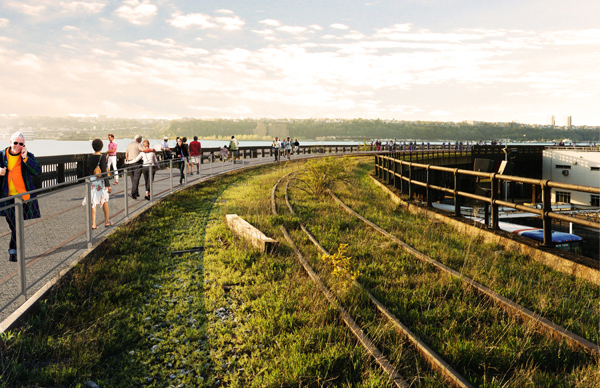
- A rendering of the High Line’s third segment by James Corner Field Operations and Diller Scofidio+Renfro, showing the interim “floating” walkway. Image courtesy of City of New York and Friends of the High Line
BY ALBERT AMATEAU | High Line enthusiasts filled the PS11 auditorium on Monday, March 12, for a design forum on the elevated park’s third and final segment that will loop around the West Side Rail Yards.
During the past three years, the first two completed segments — between Gansevoort and West 30th Streets — have attracted 3.7 million visitors.
Friends of the High Line and the city hope to begin construction on the last segment next year, with an opening projected for spring 2014.
The proposed half-mile loop around the rail yards (between 10th and 12th Avenues, from 30th to 34th Streets) will be the most challenging part to build, and will cost upward of $90 million.
James Corner and Ric Scofidio, design team members, noted that the project will have to be coordinated with The Related Companies’ commercial development above the Eastern Rail Yards (between 10th and 11th Avenues).
Related’s project will include the 1,000-foot-tall commercial “Tower C” at 10th Avenue and 30th Street for the home of the luxury goods firm Coach.
At that point the High Line will pass through Tower C and lead toward the eastern 10th Avenue “spur,” the widest part of the rail viaduct.
The 10th Avenue spur was built to allow freight trains to deliver bulk mail and packages to the upper floors of the Morgan Annex postal processing complex on the east side of 10th Avenue at 30th Street.
The spur will be part of the park — but because of its proximity to the Tower C construction site, it will open 12 to 18 months after the opening of the rest of the rail yards segment.
The main route of the High Line as it reaches the rail yards turns west at 10th Avenue, opening a view of the Hudson River. The fully designed segment, with plantings, seating and play features that echo the park’s first two segments, will cross 11th Avenue and continue over the Western Rail Yards as an interim walkway.
The interim section will be a simple path slightly elevated over the wind-sown grasses and wildflowers that have grown on the surface of the viaduct since it was closed to rail freight traffic around 1980.
In terms of the loop around the Western Rail Yards, “interim” means from five to 15 years. The Western Rail Yards are to have lower-rise residential development in the coming years.
At the March 12 design forum, the simple interim path floating above the existing steel rails and wild flowers with a view to the river was a favorite of many who asked if it could be permanent.
But Robert Hammond, a co-founder of Friends of the High Line, said that drainage work and remediation of lead paint on the structure would be necessary in the near future.
The success of the High Line was another issue for people who cited how crowded the relatively narrow paths of the first two segments have been since their openings in 2009 and 2011.
“It’s a balancing act,” responded Corner. “The biggest challenge is the ratio between soft and hard.” The more hard surface there is for people to walk on, the less soft surface there is for plants, Corner explained. Regarding crowds, he said, “We hope in the next few years it will calm down.” The audience, which Hammond estimated to number more than 200, skeptically laughed.
The design is an ongoing process and the project depends on zoning changes being considered by the city, the Metropolitan Transportation Authority (which owns the yards) and The Related Companies regarding the redevelopment of the yards.
The rail yards development project will add more than 12 million square feet of new office, residential, retail and cultural uses to the site. If the zoning is approved, Related would fund about 30 percent of the estimated $90 million cost of the High Line’s final section.
Friends of the High Line has raised $38 million for the third section. Also helping fund the park’s final part, Donald Pels and Wendy Keys have donated $5 million; Tiffany & Co. Foundation donated $5 million; and the Diller von Furstenberg Family Foundation made a $20 million pledge.
Friends also raises private funds to support more than 90 percent of the park’s annual budget.
Parks Commissioner Adrian Benepe said that in excess of $100 million in taxpayers’ money has come from the city, state and federal governments for the High Line.

















